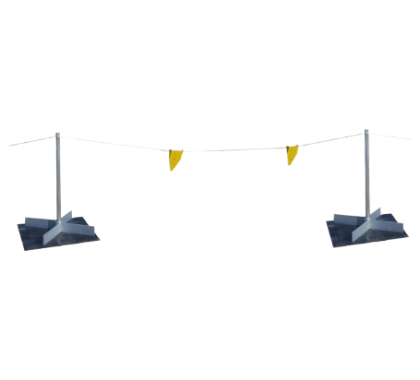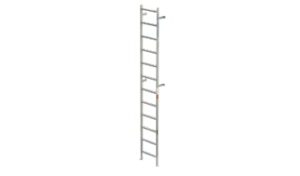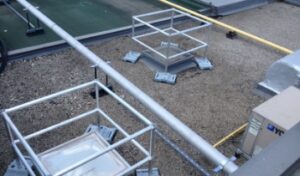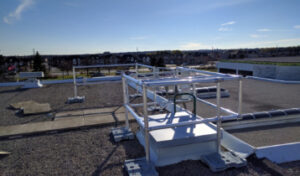Warning Lines | RoofLine Series
Warning Lines | RoofLine Series is designed for accessing areas of a flat rooftop that are nearing the roof edge (but not within 2m) to provide a visual warning to workers that are approaching a hazard. The system is freestanding, eliminating the need to pierce the roofing membrane which exposes your rooftop to potential leaks.
When a work area is enclosed by properly installed and maintained warning lines, work inside the area can be done without additional fall protection measures.

All products are customizable depending on rooftop layout
and applications and include:
- 30″ x 30″ Rubber mats to protect roof membrane
- Baseplates – X shaped galvanized steel flat bar
- Posts – 42″ Aluminum post secured to baseplates to support cable and flags
- Coated galvanized steel cable – 500 lbs breaking strength
- Flags – Powder coated metal flags

- Dimensions: L101” x W31” x H66” (257 x 79 x 168 cm)
- Designed to be a temporary warning line system

- Quick set-up, modular, free-standing
- Cost effective systems for interior or exterior demarcation
- Durable galvanized components and uprights
- Requires NO penetration of the roof membrane, therefore no leaks
- “Passive” fall protection system
- Provides site-specific coverage or provides full or partial perimeter coverage on a rooftop
- Can be utilized on a variety of applications from warning about upcoming roof edges to skylights

This system is designed to meet or exceed all major governing bodies fall protection requirements including: OSHA.
1926.502(f)(2)
Warning lines shall consist of ropes, wires, or chains, and supporting stanchions erected as follows: OSHA: A warning line is used 15′ or more from the edge. The TrafFix Devices Roof Edge Delineator warning line meets or exceeds the requirements in 1926.502(f)(2).
1926.502(f)(2)(i)
The rope, wire, or chain shall be flagged at not more than 6-foot (1.8 m) intervals with high-visibility material; Manufacturer Recommendation: Spacing between the roof edge delineators to be 6′ – 10′ (1.8 – 3 m).
1926.502(f)(2)(ii)
The rope, wire, or chain shall be rigged and supported in such a way that its lowest point (including sag) is no less than 34 inches (0.9 m) from the walking/working surface and its highest point is no more than 39 inches (1.0 m) from the walking/working surface;
1926.502(f)(2)(iii)
After being erected, with the rope, wire, or change attached, stanchions shall be capable of resisting, without tipping over, a force of at least 16 pounds (71 N) applied horizontally against the stanchion, 30 inches (0.8 m) above the walking/working surface, perpendicular to the warning line, and in the direction of the floor, roof, or platform edge;
1926.502(f)(2)(iv)
The rope, wire, or chain shall have a minimum tensile strength of 500 pounds (2.22 kN), and after being attached to the stanchions, shall be capable of supporting, without breaking, the loads applied to the stanchions as prescribed in paragraph (f)(2)(iii) of this section; and
1926.502(f)(2)(v)
The line shall be attached at each stanchion in such a way that pulling on one section of the line between stanchions will not result in slack being taken up in adjacent sections before the stanchion tips over.
1926.502(f)(3)
No employee shall be allowed in the area between a roof edge and a warning line unless the employee is performing roofing work in that area.
1926.502(f)(4)
Mechanical equipment on roofs shall be used or stored only in areas where employees are protected by a warning line system, guardrail system, or personal fall arrest system.

See a full listing of our Gargoyle Rooftop Guardrail product line.
A guide to understanding fall protection regulations and why you need Gargoyle Guardrail.
Your Perfect Solution Awaits!
The Hierarchy of Fall Protection Solutions
Elimination of Hazards
- Whenever possible, remove the fall hazard itself.
- If there is no fall hazard, there’s no fall.
Passive Systems
- Do not require the use of Personal Protective Equipment or active participation from the worker.
- Include Guardrails or Netting Systems.
- A preferred choice for its ease of use without the need for additional training and PPE.
Fall Restraint
- Uses personal fall arrest equipment (harness, lanyard, a. anchor point) to stop the user from reaching the edge.
- This type of ttying-offi p the user from falling in the first place.
Fall Arrest
- When all other solutions are infeasible.
- Fall arrest uses the same equipment as fall restraint but the fall protection equipment engages after the fall happens
- When it engages, the equipment slows the workers descent, bringing them to a safe stop.
Related Products

Fixed Access ladders
We offer a complete line of fixed access ladders that are custom fabricated to meet your exact requirements. All of our fixed access ladders are designed to be a permanent and safe means of rooftop access.

Skylight Guardrail
Fall protection guardrail systems for skylights that maintain light flow while ensuring rooftop safety.

Gargoyle Hatch Guardrail
Engineered to provide reliable fall protection around roof hatches and help prevent accidental falls during access and maintenance.

